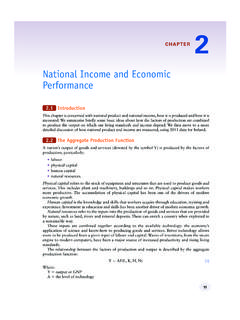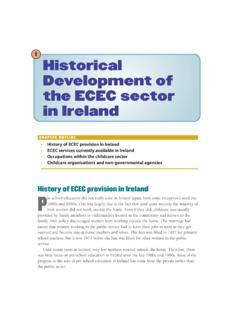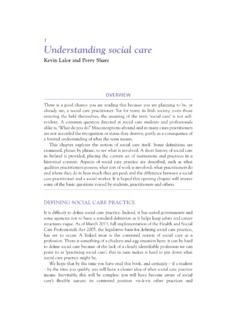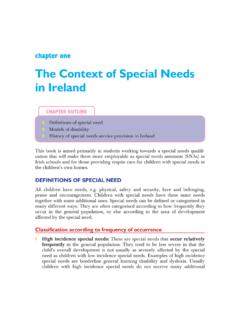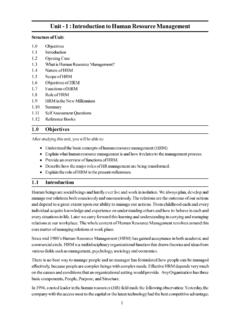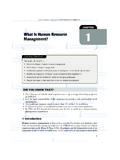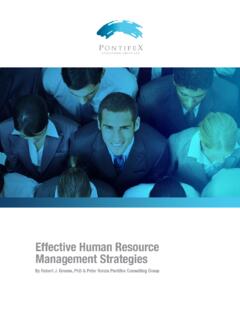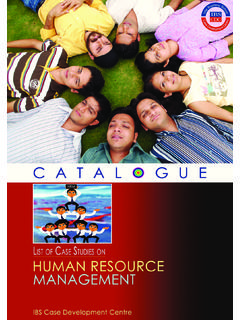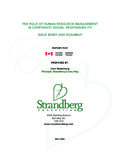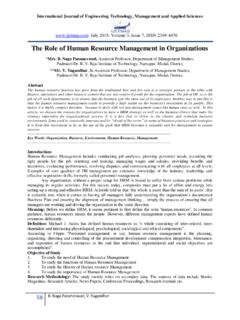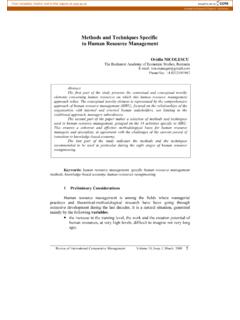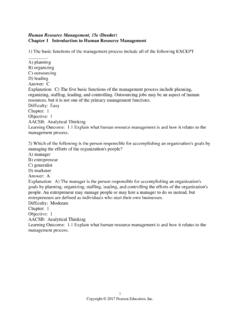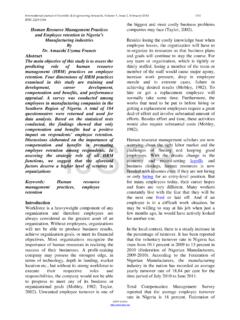Transcription of 1 INTRODUCTION TO HUMAN RESOURCE MANAGEMENT
1 01 make-grade h res TNR 2010:01 make/grade HUMAN res 19/01/2011 10:05 Page 3. 1. INTRODUCTION TO HUMAN . RESOURCE MANAGEMENT . Objectives This chapter will help you to: define HUMAN RESOURCE MANAGEMENT (HRM). become familiar with the concept of HRM and its place in an organisation trace the historical development of HRM. explain the theoretical differences between personnel MANAGEMENT and HUMAN RESOURCE MANAGEMENT discuss the context within which HR operates identify the nature of work done in HR departments outline how models of HRM can be applied in organisations discuss the current HR challenges facing organisations Definition HUMAN RESOURCE MANAGEMENT (HRM) is a style of managing people in the workplace that emerged during the 1980s.
2 It is defined by Armstrong (2006, ) as a strategic and coherent approach to the MANAGEMENT of an organisation's most valued assets the people working there who individually and collectively contribute to the achievement of its objectives'. The term strategic approach' is a key phrase in the definition of HUMAN RESOURCE MANAGEMENT and signifies the importance of a long-term game plan'. for employing and managing people at work. Armstrong (1999, ) says that HRM is concerned with the employment, development and reward of people in organisations and the conduct of relationships between MANAGEMENT and the workforce'.
3 The functions of the HR department, which involve employing, developing and rewarding workers as well as employment relations, form the focus of the rest of this book. Two approaches to HRM can be identified. Hard' HRM treats people just like any other RESOURCE to be managed effectively. The emphasis of this approach is on organisational needs rather than the needs of employees. The Soft' HRM approach recognises that because people think and feel, they 01 make-grade h res TNR 2010:01 make/grade HUMAN res 19/01/2011 10:05 Page 4. 4 Make that Grade: HUMAN RESOURCE MANAGEMENT cannot be treated in the same way as other resources.
4 The focus is on nurturing and developing staff as a means of achieving corporate aims. The Evolution of HRM. This section outlines how the style of managing people has evolved over time. It will help you to understand how the role of the HUMAN RESOURCE manager has developed over the past two hundred years. The evolution of HRM will be discussed under the following headings: 1 The origins of HRM. 2 The influence of scientific MANAGEMENT 3 The influence of behavioural science 4 Changes in people and organisations As you read, try to concentrate on how the role of the HR manager has been shaped into what it is today.
5 1 The origins of HRM. Managing people at work began at the time of the industrial revolution in the late eighteenth century. Before this time few large organisations existed, but, with the invention of new technology, the factory system developed and large numbers of people moved into the towns and cities to work. The work environment was very unfavourable at this time and employees, including young children, worked very long hours for very little pay in difficult and often dangerous working conditions. The approach to managing people was harsh and the main aim was to control the workers who had few, if any, rights.
6 Some of Charles Dickens' novels, such as Hard Times, depict the lives of the working class of this era. The first efforts to show concern for workers came toward the end of the nineteenth century when some large organisations decided to improve the situation of their employees. Companies such as Cadbury in Britain and Jacob in Ireland appointed welfare officers to improve working conditions and to set up schemes for sick pay and subsidised housing. This initiative was voluntary as the companies did not have any legal obligations to provide these benefits for their employees.
7 Even though the welfare approach suffered setbacks during times of economic recession, the concern for the welfare of workers is still an important part of HR MANAGEMENT today. This is reflected in the role of the HR manager in drawing up organisational policies on harassment and sick pay, for example. Evidence of the progress made for workers can be seen 01 make-grade h res TNR 2010:01 make/grade HUMAN res 19/01/2011 10:05 Page 5. INTRODUCTION to HUMAN RESOURCE MANAGEMENT 5. in the employment legislation regarding equality, dismissal, young workers, minimum pay and health and safety.
8 Today's HR managers must keep up to date with these legal developments to ensure that their organisation meets its obligations to employees. 2 The influence of scientific MANAGEMENT The next influence on how people were managed was scientific MANAGEMENT ', which became popular early in the twentieth century. In an effort to organise the work process more efficiently, FW Taylor asserted that there was one best way' to approach every job. To find the best way of doing a particular job, Taylor analysed the job and broke it down into individual components. This is called job specialisation.
9 Taylor believed that people could be trained to become expert at one particular component of the job. Companies like Ford took up Taylor's ideas at the time and used assembly lines to complete the job bit by bit. Taylor's ideas can be seen at work in some fast-food restaurants where the process of serving a customer is broken down into a number of tasks and each employee is responsible for one of these tasks, such as taking the customer's order, frying burgers or cooking fries. While scientific MANAGEMENT can improve efficiency, it ignores the fact that people are not machines and they can get bored doing the same thing all the time.
10 HRM today still benefits from some of the tools developed during this time. These include job analysis, methods of selection and methods of training. 3 The influence of behavioural science The research of people like Elton Mayo in the 1930s and 1940s indicated that the way people felt about their jobs influenced how they did their work. For the first time it was acknowledged that performance could be affected by concepts such as motivation, job satisfaction, group dynamics and leadership style. The main contribution of the behavioural science movement to HRM. is the knowledge gained from research in these and other areas.

